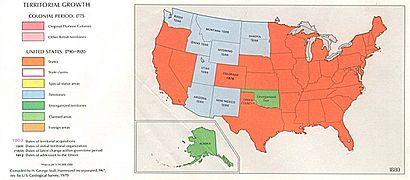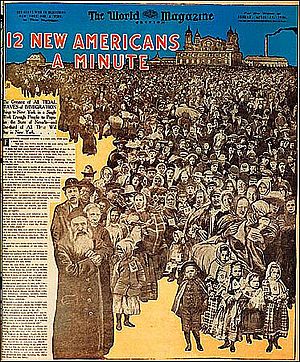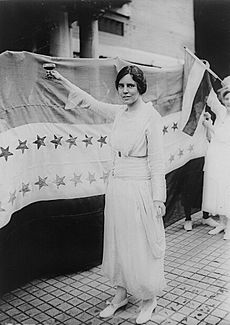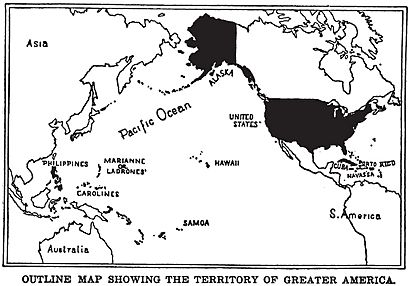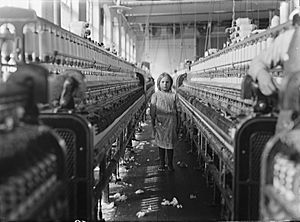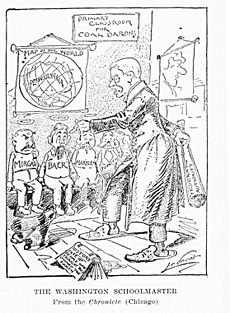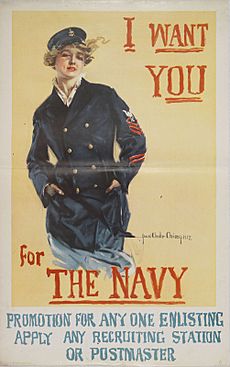History of the United States (1865–1918) facts for kids
Quick facts for kids 1865–1918 |
|
| Preceded by | History of the United States (1849–1865) |
|---|---|
| Including | Reconstruction era Nadir of American race relations Third Great Awakening Gilded Age Progressive Era |
| Followed by | History of the United States (1918–1945) |
The history of the United States from 1865 to 1918 covers a very important time. It includes the Reconstruction Era, the Gilded Age, and the Progressive Era. During this time, the U.S. became a major industrial power. This led to a huge increase in immigration. This article looks at the political, economic, and international events of these years.
After winning the Civil War in 1865, the United States became a stronger, more unified country. Slavery was ended, and formerly enslaved people gained citizenship. However, their new rights were soon taken away. They became second-class citizens under "Jim Crow" laws. These laws enforced deep segregation for many decades.
Economically, the U.S. grew very fast, especially in the North and West. It became the world's leading industrial and farming nation. The average income for non-farm workers grew a lot. From 1865 to 1900, it went up by 75%. By 1918, it grew another 33%.
Politically, the Republicans were mostly in charge, except for two Democratic presidents. After 1900, the Progressive Era brought many changes. These included reforms in politics, business, and society. Women gained the right to vote. There was also a nationwide ban on alcohol.
Millions of immigrants came to the U.S. between 1865 and 1918. They provided the workers needed for growing industries and farms. They also helped cities grow quickly. New technologies like the telegraph and steel helped the U.S. become a global industrial leader. The railroad network also expanded greatly.
The U.S. fought two important wars. In 1898, it easily defeated Spain. This led to the U.S. gaining new territories like Puerto Rico and the Philippines. Alaska was bought in 1867. Hawaii became a U.S. territory in 1898.
The U.S. tried to help make peace in World War I. But it entered the war in 1917 after Germany attacked U.S. ships. The U.S. helped the Allied Forces win by providing money, food, and millions of fresh soldiers.
Contents
- Rebuilding the Nation: The Reconstruction Era (1863-1877)
- Settling the West: New Frontiers and Challenges
- Industrial Growth: The Second Industrial Revolution
- The Gilded Age: Wealth and Change (1870s-1900)
- Social Changes in America
- Women's Fight for the Vote
- America's Role in the World
- The Progressive Era: Reforming America
- World War I: America Enters the Global Conflict
- Images for kids
Rebuilding the Nation: The Reconstruction Era (1863-1877)
Reconstruction was a period from 1863 to 1877. During this time, the federal government took control of the Southern states that had been part of the Confederacy. President Abraham Lincoln wanted to bring the Southern states back into the Union quickly. He created the Freedmen's Bureau in 1865. This group helped formerly enslaved people find education, healthcare, and jobs.
Slavery was officially ended by the Thirteenth Amendment in December 1865. However, some politicians, called Radical Republicans, worried that former Confederates would try to bring back slavery. They wanted to limit the rights of ex-rebels. Lincoln's successor, President Andrew Johnson, disagreed with the Radicals. But the Radicals won important elections in 1866. They gained enough power in Congress to pass laws over Johnson's objections. They even tried to remove him from office in 1868.
In 1867, the Radicals' plans began. The U.S. Army oversaw the Southern states. This allowed a new group of Republicans to take control of Southern state governments. This group included freedmen (formerly enslaved people), Scalawags (Southern whites who supported Reconstruction), and Carpetbaggers (Northerners who moved South). These new governments passed the Fourteenth Amendment. This amendment gave the federal courts more power to ensure justice at the state level.
These state governments borrowed money to build railroads and public schools. This led to higher taxes. Many white Southerners opposed these changes. President Ulysses S. Grant worked to protect the civil rights of African Americans. The Fifteenth Amendment was passed in 1870. It gave African Americans the right to vote.
Reconstruction ended at different times in each state. The last states saw it end in 1877. This happened after a close presidential election between Republican Rutherford B. Hayes and Democrat Samuel J. Tilden. A special commission gave the disputed votes to Hayes. In return, Hayes agreed to remove the Army from the remaining Southern states. Many Northerners felt the Civil War was truly over.
The end of Reconstruction meant African Americans in the South lost many of their civil rights. White Southerners felt angry and distrustful of the federal government. This led to the "Solid South," where people mostly voted for conservative Democrats. White supremacists created a segregated society. They used "Jim Crow Laws" to make Black people second-class citizens. This meant Black people had little political power or public voice.
Historians have different ideas about why Reconstruction failed. Some think it went too far, too fast. Others believe it didn't go far enough to protect Black rights. However, some historians also see it as a success. They point to the Union staying together and slavery being permanently ended.
Settling the West: New Frontiers and Challenges

In 1869, the First Transcontinental Railroad was completed. This opened up the mining and ranching areas of the Far West. A trip from New York to San Francisco now took only six days. Before, it took six months. After the Civil War, many people from the East Coast and Europe moved West. They were drawn by stories from relatives and by advertisements. These ads promised cheap, fertile land.
The new railroads made it easier for people to explore the West. They offered special family tickets. The cost of these tickets could even be used for land purchases. Farming the plains was harder than in the East. Water was more important, and lightning fires were common. The weather was more extreme, and rainfall was less predictable.
People moved West mainly for a better economic life. Farmers wanted larger, cheaper, and more fertile land. Merchants looked for new customers. Laborers hoped for higher-paying jobs. The Homestead Acts gave free land to citizens. Railroads sold cheap land to European farmers. Because of this, the Great Plains were settled quickly. The frontier was mostly gone by 1890.
Native American Assimilation
As settlers moved into the plains and mountains, conflicts arose with some Native American tribes. The government wanted Native Americans to either join American society or stay on reservations. The Army used force to keep tribes on reservations from threatening others. Violence decreased in the 1880s and mostly stopped after 1890. By 1880, the buffalo herds, which were vital for hunting, had disappeared.
Native Americans could choose to live on reservations. The U.S. government provided food, supplies, education, and medical care. Individuals could also leave reservations and work in Western society. Reformers wanted Native Americans to own their own farms. The Dawes Act of 1887 tried to help Native Americans join mainstream society. Most accepted this and became part of American life. Those who refused to assimilate often remained poor on reservations. In 1934, the Indian Reorganization Act changed policy. It aimed to protect tribal life on reservations.
Farming Life and Challenges
Farming expanded greatly during this period. The number of farms tripled from 2 million in 1860 to 6 million in 1905. The number of people living on farms also grew. The value of farms increased from $8 billion in 1860 to $30 billion in 1906.
The government gave away 160-acre plots of land for free under the Homestead Acts of 1862. Many more people bought land cheaply from the new railroads. The railroads advertised in Europe and brought thousands of farmers from Germany, Scandinavia, and Britain.
Despite their progress, farmers faced difficulties. World prices for cotton and wheat often fell. New machines helped increase crop yields. But the amount of land farmed also grew quickly. Farmers in the West relied heavily on railroads to move their goods. This led to protests, like the Populist movement in the 1890s. Farmers blamed grain elevator owners, railroads, and bankers for low prices.
The Grange movement was the first organized effort to help farmers. It grew to 1.5 million members. Granges set up their own stores and cooperatives. Most of these failed. However, the movement had some political success. Some Midwestern states passed "Granger Laws" to limit railroad and warehouse fees.
Family Life on the Frontier
Few single men tried to run a farm alone. Farmers knew they needed a hard-working wife and many children. They helped with chores, raising children, and feeding the family and hired workers. Early on, farm women worked outdoors to help the family survive. Later, women spent more time on domestic tasks. New inventions like sewing and washing machines helped with this. The scientific housekeeping movement also encouraged women to focus on home duties.
Life on the prairies was not as isolated as some might think. Rural people created a rich social life. Many joined the Grange or local churches. They organized activities that combined work, food, and fun. These included barn raisings, corn huskings, and quilting bees. Women organized shared meals and visited other families.
Childhood on the frontier is seen in different ways by historians. Some say it was good for children. They believe it made children more self-reliant and adaptable. Others describe it as a difficult life with loneliness, hardship, and hard physical labor from a young age.
Industrial Growth: The Second Industrial Revolution
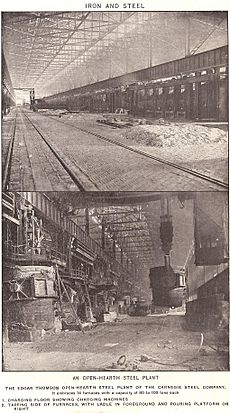
From 1865 to about 1913, the U.S. became the world's top industrial nation. This was due to many factors. The country had plenty of land and workers. It had diverse climates and many railroads and rivers for transport. There were also rich natural resources like coal, timber, and oil. All of this made energy cheap and transport fast. It also provided the money needed for the Second Industrial Revolution.
The First Industrial Revolution moved production from small workshops to factories. The Second Industrial Revolution expanded how work was organized. It used new technologies and transportation. Railroads opened up the West, creating new farms, towns, and markets. The Transcontinental Railroad was built by entrepreneurs with British money and Irish and Chinese workers. It gave access to huge areas of land.
New technologies in iron and steel, like the Bessemer process, greatly improved how much could be produced. New communication tools, such as the telegraph and telephone, helped managers coordinate work over long distances. Ideas like scientific management also changed how work was organized.
To pay for these large businesses, the corporation became the main type of business. Corporations grew by merging with others, creating "trusts" (a type of monopoly). High tariffs protected U.S. factories from foreign competition. Federal land grants for railroads helped investors and farmers. Businesses often went to court to stop workers from forming unions or striking.
Powerful industrialists like Andrew Carnegie and John D. Rockefeller became very rich. Critics called them "robber barons." In 1888, Rutherford B. Hayes wrote that the U.S. was becoming a "government of the corporation." Skilled workers and engineers were in high demand. Many immigrants provided cheap labor, especially in mining and factories.
Working Conditions and Labor Unions
In the growing industrial sector, wages were higher than in Europe. But the work was harder, with less free time. Economic downturns in 1873–75 and 1893–97 caused low farm prices and high unemployment. Full prosperity returned in 1897 and lasted until 1920.
The number of unskilled workers grew constantly. Millions of immigrants arrived between 1865 and 1918. Most were young men looking for work. The demand for engineers and skilled workers was high due to new technology. Before 1874, there were almost no laws about working hours. Child labor peaked around 1900. It then declined as laws kept children in school. Child labor was finally ended in the 1930s.
The first major effort to organize workers nationwide was the Knights of Labor in 1869. It was open to all workers, including African Americans, women, and farmers. The Knights grew quickly after a successful strike against railroad owner Jay Gould in 1885.
The Knights of Labor later declined. The American Federation of Labor (AFL) took its place. The AFL, led by Samuel Gompers, focused on skilled workers. Its goals were simple: higher wages, fewer hours, and better working conditions. Gompers helped move the labor movement away from socialist ideas. The AFL became a respected organization, but it did not include unskilled laborers.
Economic depressions led to anger among workers. This caused violent conflicts in 1877 and 1894. In the Great Railroad Strike of 1877, railroad workers struck over a pay cut. Attempts to end the strike led to violence in several cities. The Haymarket Riot happened in 1886. A bomb was thrown at a strike rally in Chicago, killing police officers. This weakened the labor movement.
In 1892, at Carnegie's steel works in Homestead, Pennsylvania, a strike turned violent. Company guards and strikers were killed. The National Guard was called in. Non-union workers were hired, and the strike was broken. Unions were banned at the Homestead plant until 1937.
Two years later, a strike at the Pullman Palace Car Company stopped the nation's railway industry. President Grover Cleveland sent in the Army to stop the rioting. The strike ended, and the union collapsed.

The Industrial Workers of the World (IWW) was a very active workers' group from 1905 to 1920. They formed because of bad working conditions and discrimination against women, minorities, and unskilled workers. The "Wobblies," as they were called, wanted "One Big Union" for all workers. They gained fame after winning a textile strike in Lawrence in 1912. The IWW was not effective at peaceful labor relations. They also strongly opposed World War I. This led to government action against them. Many Wobblies were harmed or jailed.
The Gilded Age: Wealth and Change (1870s-1900)
The "Gilded Age" was a time of great wealth for the richest Americans. It followed the economic recovery from the Panic of 1873. This era was built on the new industrial economy. It created a class of super-rich "captains of industry," also called "robber barons." These powerful people had vast business and social connections. The term "Gilded Age" was created by Mark Twain and Charles Dudley Warner in their 1873 book. It meant something that looked shiny and golden on the outside, but might not be so great underneath.
After Reconstruction ended, there were fewer major political issues. The 1880 presidential election was very quiet. James A. Garfield won, but was shot a few months later. His Vice President, Chester A. Arthur, became president.
Reformers, like the "Mugwumps," complained about corruption in politics during this time. Voter turnout was very high from 1872 to 1892. Key issues included modernizing the country, money, railroads, corruption, and the ban on alcohol. National elections were often very close. In 1884, Democrat Grover Cleveland, a reformer, defeated Republican James G. Blaine. Cleveland tried to lower tariffs and expand civil services.
The wealthy class in the Northeast celebrated an "American Renaissance." This was seen in many new public buildings. Hospitals, museums, colleges, and libraries were built. They often used the grand Beaux-Arts architecture style. This style became popular after the World's Columbian Exposition in Chicago in 1893.
Social Changes in America
Cities grew rapidly, a process called urbanization. This happened alongside industrialization, as factories and railroads expanded. High levels of immigration made this growth possible.
Immigration to the United States
From 1865 to 1918, 27.5 million immigrants arrived in the U.S. This was a huge and diverse group. Most, about 24.4 million, came from Europe. This included people from Great Britain, Ireland, Scandinavia, Germany, Italy, and Eastern Europe. Another 1.7 million came from Canada.
Most immigrants arrived through New York City, especially Ellis Island after 1892. Different groups settled in different places. New York and other East Coast cities became home to large Jewish, Irish, and Italian communities. Many Germans and Central Europeans moved to the Midwest for jobs in industry and mining. About one million French Canadians moved from Quebec to New England.
Immigrants left their home countries due to poverty or threats. They came to America for jobs, farmland, and family connections. They found work in factories, mines, and construction. They also found farming opportunities in the Plains states.
While most immigrants were welcomed, Asians faced challenges. Many Chinese came to the West Coast to build railroads. But they were seen as very different from Europeans. After strong anti-Chinese feelings in California, Congress passed the Chinese Exclusion Act in 1882. This law stopped Chinese immigration. An agreement in 1907, the Gentlemen's Agreement, stopped Japanese immigration.
Some immigrants stayed in the U.S. temporarily. They saved money and then returned home. But most left their native lands permanently. They stayed in America hoping for a better life. This hope for freedom and success led to the idea of the American Dream.
Religion in a Changing Nation
The Third Great Awakening was a period of religious revival. It happened from the late 1850s to the early 1900s. It focused on social activism and the idea that mankind could improve the world before Christ's return. The Social Gospel Movement, which applied Christian ideas to social problems, grew from this awakening. New religious groups also appeared.
The Catholic Church grew quickly. Its members were mainly German, Irish, Polish, and Italian immigrants. They built churches, schools, and colleges. The Jewish community also grew fast, especially in New York City. New arrivals from Eastern Europe formed Orthodox and Conservative synagogues.
Challenges for African Americans
Starting in the late 1870s, African Americans lost many civil rights gained during Reconstruction. They faced increasing racial discrimination. Jim Crow laws were put in place after the Compromise of 1877. These laws enforced segregation. Conditions for African Americans in the South became much harder. Many moved to the Midwest starting in 1879. This movement grew into the Great Migration before World War I.
In 1896, the U.S. Supreme Court upheld the Jim Crow system. It ruled that "separate but equal" facilities were legal. This meant segregation was allowed.
The Rise of Populism
By 1880, the Grange movement declined. It was replaced by the Farmers' Alliance. This group had strong economic plans. They wanted to protect farmers from powerful businesses. Their goals included regulating railroads, increasing the money supply, and lowering tariffs. These were called the Ocala Demands.
In the late 1880s, droughts hit the West hard. Many farmers faced severe problems. By 1890, farmers' distress was at an all-time high. A new political party, the Populist Party, emerged. They gained power in some Southern and Western states. They also sent Populist senators and representatives to Congress.
The Populist platform focused on land, railroads, and money. They wanted unlimited coinage of silver. Farmers believed that more money in circulation would raise prices for their products. This would help them pay off debts.
However, conservative groups and bankers disagreed. They thought increasing the money supply would be disastrous. They argued that only the gold standard offered stability. The Panic of 1893 made this debate even more tense. Banks failed, unemployment rose, and crop prices fell.
The Democratic Party, which supported silver, absorbed many Populists. In the 1896 election, William Jennings Bryan, a champion of silver, became the Democratic candidate. He lost to Republican William McKinley, who supported the gold standard.
After 1897, the economy improved. The Spanish–American War in 1898 also shifted the nation's focus. Although the Populist movement faded, some of its ideas lived on. Years later, reforms like the direct election of Senators were passed.
Women's Fight for the Vote
The women's suffrage movement began in 1848 with the Seneca Falls Convention. Many activists had experience from the movement to end slavery. After the Civil War, the movement reorganized. Many women who had worked for the ban on alcohol joined. By the late 1800s, a few Western states had given women full voting rights. Women also gained important legal rights in areas like property and child custody.
Around 1912, the movement gained new energy. Women argued that they were needed to improve American politics. Protests became more common. Alice Paul led parades through cities. Paul formed the more active National Woman's Party. This group split from the larger National American Woman Suffrage Association (NAWSA). Suffragists were arrested for picketing the White House. They were treated as political prisoners.
Eventually, the suffragettes were released. President Woodrow Wilson urged Congress to pass a constitutional amendment. The argument that only men who fought in wars deserved to vote was challenged. Tens of thousands of American women helped on the home front during World War I. Many Western states had already given women the right to vote. In 1919, Congress passed the Nineteenth Amendment. It became law on August 26, 1920.
America's Role in the World
After William McKinley won the 1896 election, a decade of fast economic growth began. This boosted national confidence. McKinley brought a new way of governing. He believed politics was about finding compromises for the good of the nation. His approach focused on economic growth and prosperity for everyone. He felt parties should carry out the people's will and teach new ideas.
War with Spain and New Territories (1898)
Spain once had a huge empire, but by the late 1800s, only Cuba, Puerto Rico, the Philippines, and some African lands remained. Cubans had been rebelling since the 1870s. American newspapers, especially those using "Yellow Journalism," printed shocking stories about Spanish actions in Cuba. Many Americans called for the U.S. to get involved.
On February 15, 1898, the battleship USS Maine exploded in Havana Harbor. The cause was unclear, but many Americans believed Spain was responsible. The U.S. prepared for war. It was made clear that Cuba would gain independence, not be taken over by the U.S. Spain saw this as interference and broke off relations. War was declared on April 25.
Spain was quickly defeated. Theodore Roosevelt's Rough Riders became famous in Cuba. Commodore George Dewey's fleet crushed the Spanish in the Philippines. Spain surrendered, ending the three-month war. Cuba became independent. Puerto Rico, Guam, and the Philippines were given to the United States.
Some politicians hoped these new territories would help expand trade with Latin America and Asia. This didn't happen much. After 1903, American attention turned to the Panama Canal as a key trade route. The Spanish-American War marked the start of the U.S.'s active global foreign policy.
The Philippines and Latin America
The U.S. gained the Philippines from Spain in 1898. But Filipino revolutionaries, led by Emilio Aguinaldo, declared independence. They fought U.S. troops in the Philippine–American War until 1901. Roosevelt continued McKinley's policies. He removed Catholic friars, improved infrastructure, and started public health programs. He also began to prepare the islands for self-government. The Philippines fought alongside Americans when Japan invaded in 1941. They gained independence in 1946.
The U.S. focused more on the Caribbean. The growth of Pacific states like California showed the need for a canal connecting the Atlantic and Pacific Oceans. Under Roosevelt, the U.S. built the Panama Canal, which opened in 1914.
In 1904, Roosevelt announced his "Roosevelt Corollary" to the Monroe Doctrine. This stated that the U.S. would intervene in Latin American countries if their governments were unstable. The U.S. intervened many times to stabilize governments and help economies grow. This policy ended in the 1930s. The U.S. also intervened in Mexico during its revolution. In 1914, U.S. troops occupied Veracruz. In 1916, Gen. John J. Pershing led troops into Mexico to pursue Pancho Villa.
The Progressive Era: Reforming America
A new movement called "Progressivism" emerged in the 1890s. It lasted into the 1920s.
The 1900 presidential election allowed Americans to judge the McKinley administration. Republicans celebrated the victory over Spain and the return of prosperity. The election was similar to 1896, but American imperialism was a new issue. William Jennings Bryan added anti-imperialism to his platform, but he lost to McKinley.
President William McKinley was very popular. But in September 1901, he was shot by an anarchist. He was the third U.S. President to be assassinated. Vice President Theodore Roosevelt became president.
Political corruption was a big problem. Reformers wanted to fix this with civil service reforms. This meant hiring people based on merit, not political connections. The 1883 Pendleton Civil Service Reform Act put most federal employees on a merit system. However, local governments often remained corrupt.
Many progressives saw their work as a fight against corrupt politicians and "robber barons." They demanded better regulation of businesses. They also wanted the government to do more to help the country. Many important people of the time were part of this reform movement.
Journalists, called "Muckrakers," wrote articles exposing problems. Ida Tarbell wrote about the Standard Oil Trust. Upton Sinclair's novel, The Jungle, exposed unsanitary conditions in meatpacking plants.
These writings encouraged people to take political action. Many states passed laws to improve living and working conditions. Child labor laws were strengthened. They raised age limits and shortened work hours. Most large cities and states set an eight-hour day for public works. Workers' Compensation Laws made employers responsible for worker injuries. New tax laws, like the inheritance tax, laid the groundwork for the modern federal income tax. By the end of the Progressive Era, many laws addressed workplace issues.
Theodore Roosevelt's Presidency (1901-1909)
Roosevelt, a progressive Republican, promised a "Square Deal." He increased federal oversight of businesses. He also enforced antitrust laws. Later, he pushed for more railroad regulation. In 1906, Congress passed the Hepburn Act. This gave the Interstate Commerce Commission real power to regulate railroad rates. Roosevelt also helped settle the Coal Strike of 1902, which threatened fuel supplies.
Protecting the nation's natural resources was very important to Roosevelt. He made this issue widely known. He called for a large program of conservation and irrigation. His predecessors had set aside 46 million acres of land for parks. Roosevelt increased this to 146 million acres. He also started efforts to prevent forest fires. He appointed Gifford Pinchot as chief forester. Roosevelt added 50 wildlife refuges and 5 new national parks. He also started the system of designating national monuments.
President William Howard Taft (1909-1913)
Roosevelt supported William Howard Taft to be his successor. Taft, a former judge, continued to prosecute trusts. He strengthened the Interstate Commerce Commission. He also established a postal savings bank and a parcel post system. He expanded the civil service.
Taft also supported two new amendments to the U.S. Constitution. The 16th Amendment allowed a federal income tax. The 17th Amendment, ratified in 1913, allowed people to directly elect U.S. Senators. Before, senators were chosen by state legislatures.
However, Taft's support for a high tariff angered progressives. He also faced criticism for his opposition to statehood for Arizona and his stance on environmental issues. Roosevelt became his enemy by 1910. The Republican Party split. Democrats gained control of Congress in the 1910 United States elections.
President Woodrow Wilson (1913-1921)
In 1912, Woodrow Wilson, a progressive Democrat, ran for president. He ran against Taft and Roosevelt. Roosevelt ran as a third-party candidate. Wilson won the election.
Under Wilson, Congress passed many important laws. First, they revised tariffs. The Underwood Tariff lowered rates on many imported goods. This was meant to lower the cost of living for American workers.
Next, they reformed the banking system. Wilson believed control of money should be public, not private. The Federal Reserve Act of 1913 was a major achievement. It created 12 Federal Reserve Banks supervised by a Federal Reserve Board. These banks helped control the money supply. Before this, private banks largely controlled it. The Fed opened in 1914 and helped fund World War I.
To deal with trusts, Wilson's administration used the new Federal Trade Commission. This commission could stop "unfair methods of competition." The Clayton Antitrust Act also banned certain corporate practices. After 1914, the issue of trusts became less important in politics.
The Adamson Act of 1916 set an eight-hour day for railroad workers. This strengthened ties between labor unions and the Democratic Party. Wilson became known as a major liberal reformer. However, his role as a wartime president would soon overshadow his domestic achievements.
World War I: America Enters the Global Conflict
America's Entry into World War I (1917)
When World War I began in Europe in 1914, the United States stayed neutral. It supplied the Allies (Britain, France, Russia). But it could not send goods to the Central Powers (Germany, Austria-Hungary) due to a British blockade. Many Americans, especially those with British ties, favored the Allies. However, many Irish Americans and German Americans opposed U.S. involvement.
Germany's use of submarines (U-boats) to blockade Britain led to American deaths. Attacks on passenger ships, like the Lusitania in 1915, caused public outrage. Germany promised to stop, but reversed its decision in early 1917. It believed unrestricted U-boat warfare would win the war, even if it meant the U.S. joined.
Americans also learned about the Zimmermann Telegram. This was a German offer for Mexico to go to war with Germany against the U.S. In return, Mexico would get back lost territories like Arizona, New Mexico, and Texas. On April 1, 1917, Wilson called for war. He said the U.S. had to fight for its honor and to help shape the postwar world. Congress declared war on April 6, 1917.
Life on the Home Front During WWI
The U.S. was not ready for a major war in 1917. Its military was small and used old weapons. A quick expansion and modernization began. The draft started in spring 1917. Four million men and thousands of women joined the military.
In 1917, there was much confusion in producing war supplies. A coal shortage hit in December 1917. There was plenty of coal, but it was stuck in railroad traffic jams. The government took control of coal mines and railroads. They also shut down factories one day a week to save fuel.
The war saw many women take jobs traditionally held by men. Many worked in factories making tanks and munitions. For the first time, department stores hired African American women for certain jobs. The Food Administration helped housewives prepare meals with less waste. Millions of women volunteered for the Red Cross.
Samuel Gompers, head of the American Federation of Labor, and most unions supported the war. They minimized strikes as wages rose and unemployment was low. Unions encouraged young men to enlist. They opposed anti-war groups like the Industrial Workers of the World (IWW). The IWW fought against the war and was shut down by the government.
American Soldiers in Europe
On the Western Front in spring 1918, fresh American troops were welcomed by the tired Allied armies. Americans arrived at a rate of 10,000 a day. Germany could not replace its losses. After the Allies stopped the final German offensive, Americans played a key role in the Allied final push. Victory over Germany was achieved on November 11, 1918. American soldiers fought for honor, duty, and their comrades.
The Treaty of Versailles and the League of Nations
Britain, France, and Italy imposed harsh penalties on Germany in the Treaty of Versailles. The United States Senate did not approve the Treaty of Versailles. Instead, the U.S. signed separate peace treaties with Germany. The Senate also refused to join the new League of Nations on Wilson's terms. Wilson rejected the Senate's compromise proposal.
Images for kids



